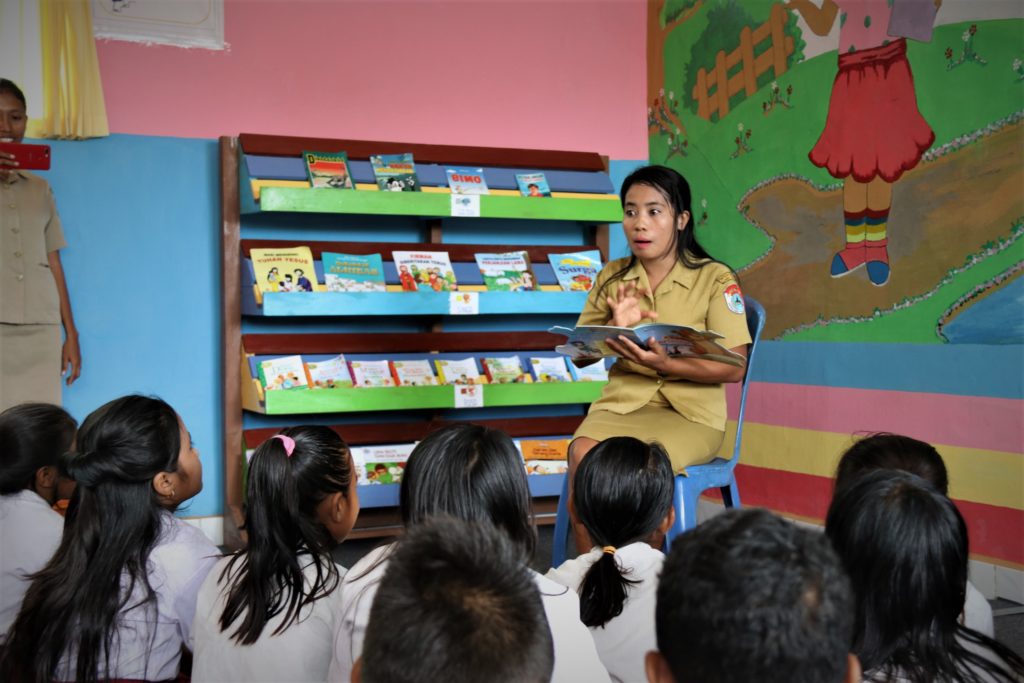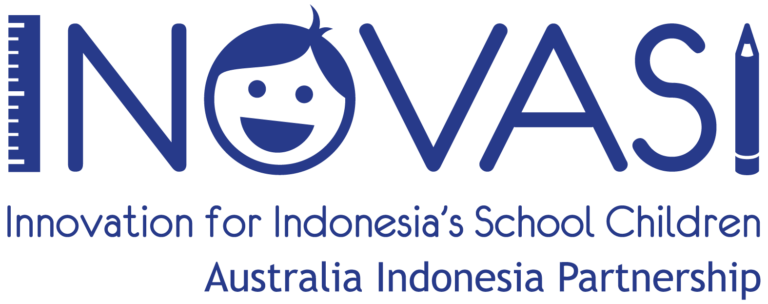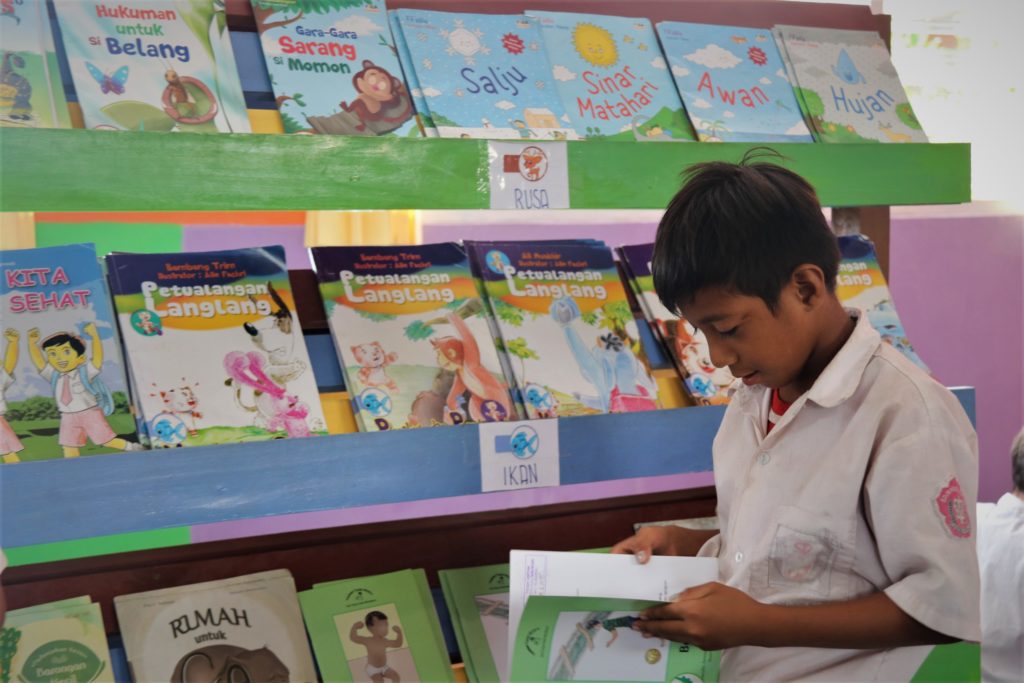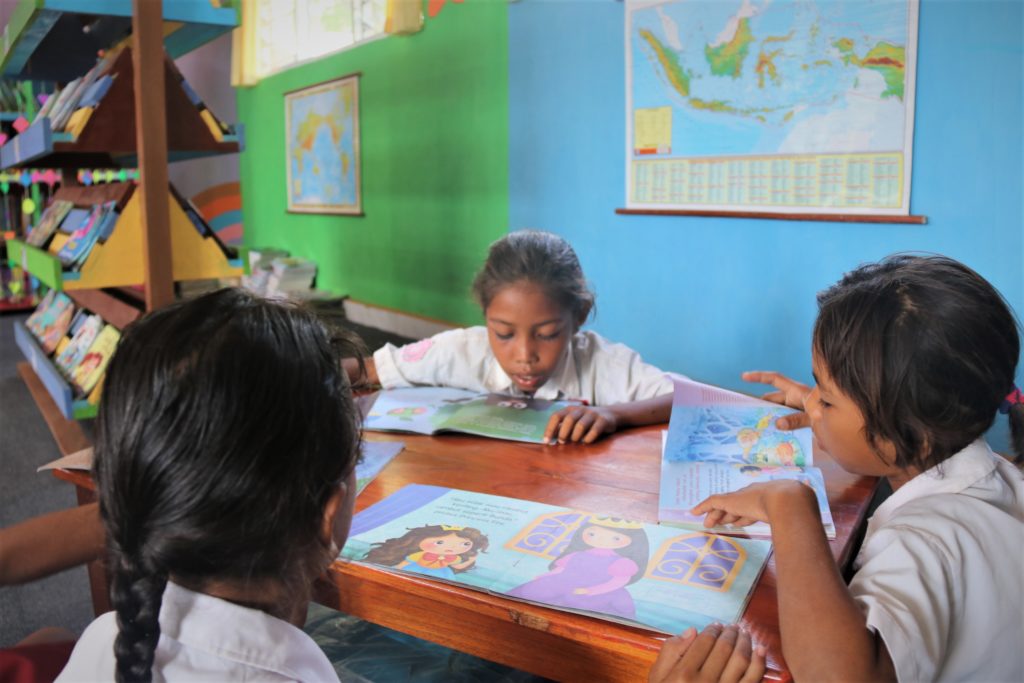
Mery recounted, “The room was only used to store teaching aids, mattresses, and unused school items. There were books, but they were mostly stored in cardboard boxes. The books on display were simply stacked on shelves and not organized.”
This was the scene before the school received intervention from the INOVASI Child-Friendly Library program and Taman Bacaan Pelangi (TBP, or Rainbow Reading Gardens). At the time, there was no reading program in the library; the students only visited the library when they had assignments from their teachers. The book collections stacked on the shelves were books that supported learning, such as encyclopedias, Indonesian dictionaries, and books on cultural arts.
Meanwhile, the library manager and the other educators at the school believed that a librarian’s job was to log books that the students borrowed, take inventory of the books, and nothing more.
However, after going through two weeks of intensive training, Mery appointed a new library manager, Yumiati Nina Kana, who was previously a mathematics teacher. The training, which was attended by the school principal, teachers, and librarians, focused on library management and reading activities.
Child-Friendly Library Program
Through this collaborative program, Taman Bacaan Pelangi has provided quality children’s story books for the children to read in the library or to borrow and read at home. Taman Bacaan Pelangi also provides capacity-building trainings for teachers: Child-Friendly Library Management and Reading Activities in the Library.
Through these two types of training, school principals, librarians, and teachers are trained to become child-friendly and active educators and conduct reading activities in the library. These reading activities include Reading Aloud, Reading Together, Reading in Pairs, and Reading Independently.
Librarians are also trained to manage libraries efficiently, which makes their work easier.
The books that have been provided to the library collection are arranged according to the level of difficulty of the books and the student’s reading abilities. There are six levels of books that were introduced through the program, starting from the easiest level and progressing to the highest level: Beetle, Bird, Fish, Deer, Lion, and Elephant. The books at the Lion and Elephant levels are suitable for fluent readers.
To start cultivating reading habits at the school, the principal agreed to include a library visiting schedule in the routine schedule for each class. This way, each class has at least one lesson hour, around 35 minutes, to visit the library every week. During the library visit, the class teacher assists the children and conducts the four reading activities that were introduced during the training.
Maximizing the benefits of School Libraries—A Positive Change
Today, the library building at SD Inpres Laipori has been transformed into a fun reading place with interesting painted walls. The students’ parents took part in renovating the building while one of the teachers at an elementary school in the district painted the walls with many interesting pictures.
The books have also been arranged so that they are easily accessible to students according to their reading abilities. The easy level books are placed on the bottom shelf, and as the shelves go higher, the levels of the books also go higher, becoming more difficult. Nina and the class teachers used the guidelines provided by TBP to sort each book according to its level.
TBP provided 1,336 books with various titles to the library. In addition to this, the school added 621 more books to its collection, which were taken from the pile of boxes that were still neatly wrapped. “It turned out that we already had good books. However, we hadn’t used them until now,” said Nina. These books have also been sorted according to the grading guidelines by TBP.
Reading with Expression Activity
The reading in the library program is up and running. During the week, each class gets a turn to read in the library for 35 minutes. During this visit, the class teacher is obliged to assist the students; the four reading activities are usually carried out during the visit.
For most teachers, the reading aloud activity is considered as something new. This activity is also considered unique because they read the books with expressions to the children so that the children feel happy and become motivated to read.
During the reading aloud activity, the teacher selects a book and reads it aloud to the students. This activity aims to show students the proper use of punctuation marks and expressions. During each activity, the teacher introduces or explains new or difficult words according to the local context so that the students can better understand them.
In early 2020, several representatives from the Afghan Ministry of Education visited SD Inpres Laipori to see how learning is conducted at this school, including the use of the library to improve the students’ reading interest. In the library, the representatives were able to observe the reading aloud activity that one of the teachers was conducting.
“I’ve never seen a teacher read a story like this in Afghanistan. The teacher was really immersed in the story, and the students seemed to be drawn into the story,” said Shafiullhaq Rahimi, Deputy Chief of Party for the Afghan Child Read program, who was one of the visitors.
As the school principal, Mery does not demand much from her students. “What is important is that they want and like (to read) first. Their abilities will naturally improve when they read frequently,” explained Mery.
According to Nina, reading activities like this make students enthusiastic about reading. Their abilities also improve. “In the past, the teachers just read straight on, like running water. Now they read with expressions and follow the punctuation marks,” said Nina.








